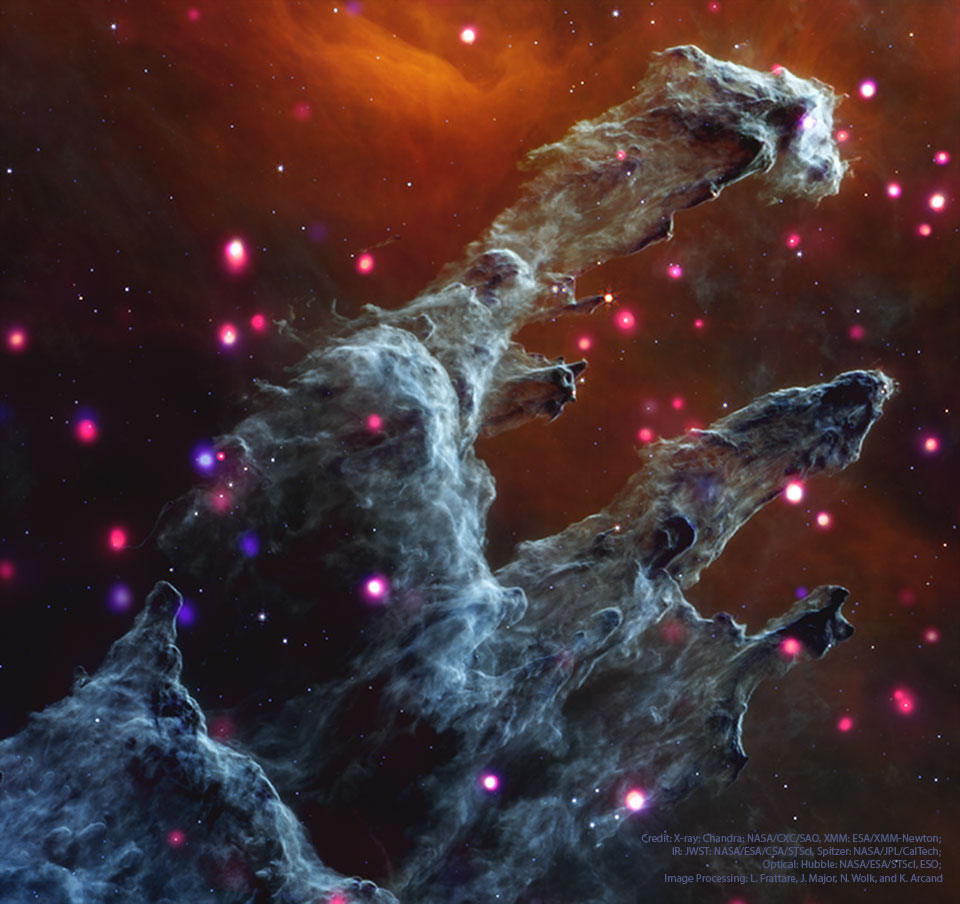2023年7月25日
The Eagle Nebula with X-ray Hot Stars
Image Credit: X-ray: Chandra: NASA/CXC/SAO, XMM: ESA/XMM-Newton; IR: JWST: NASA/ESA/CSA/STScI, Spitzer: NASA/JPL/CalTech; Visible: Hubble: NASA/ESA/STScI, ESO; Image Processing: L. Frattare, J. Major, N. Wolk, and K. Arcand
Explanation: What do the famous Eagle Nebula star pillars look like in X-ray light? To find out, NASA’s orbiting Chandra X-ray Observatory peered in and through these interstellar mountains of star formation. It was found that in M16 the dust pillars themselves do not emit many X-rays, but a lot of small-but-bright X-ray sources became evident. These sources are shown as bright dots on the featured image which is a composite of exposures from Chandra (X-rays), XMM (X-rays), JWST (infrared), Spitzer (infrared), Hubble (visible), and the VLT (visible). What stars produce these X-rays remains a topic of research, but some are hypothesized to be hot, recently-formed, low-mass stars, while others are thought to be hot, older, high-mass stars. These X-ray hot stars are scattered around the frame — the previously identified Evaporating Gaseous Globules (EGGS) seen in visible light are not currently hot enough to emit X-rays.
Tomorrow’s picture: undersea overhead
鹰状星云与X射线热星
影像提供: X-ray: Chandra: NASA/CXC/SAO, XMM: ESA/XMM-Newton; IR: JWST: NASA/ESA/CSA/STScI, Spitzer: NASA/JPL/CalTech; Visible: Hubble: NASA/ESA/STScI, ESO; 影像处理: L. Frattare, J. Major, N. Wolk, and K. Arcand
说明: 著名鹰状星云的星柱,在X射线波段是何模样?为了找出答案,NASA的钱德拉X射线天文台,望穿了这些在诞生恒星的星际山脉。从而发现在M16中尘埃柱本身并不会发出太多的X射线辐射,但倒是找到许多小而明亮的X射线源。在这幅整合了钱德拉 (X射线)、XMM(X射线)、韦伯(红外光),斯皮策(红外光),哈勃(可见光)和甚大望远镜(可见光)数据的组合主题影像里,这些X射线源是其内的明亮光点。到底是那种恒星产生了X射线,目前仍然是一个研究的题材,但有假说认为是最近刚形成的炽热小质量恒星,而其他假说则认为应是炽热较高龄的大质量恒星。这些X射线热星散布在视野各处,而先前在可见光波段辨认出的蒸发中气态云球(EGGS),目前还没热到能发出X射线。
明日的图片: undersea overhead







